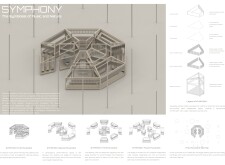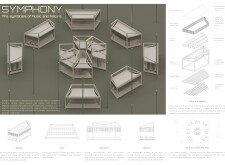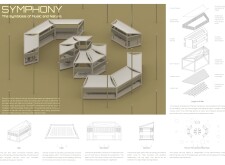5 key facts about this project
### Overview
Located within a forested setting, SYMPHONY is designed to create an immersive experience that intertwines music and nature. The project's intent is to provide flexible spaces that enhance auditory and visual experiences during various performances. By integrating musical elements into the natural landscape, the design reflects a commitment to fostering a dynamic relationship between artists, audiences, and the surrounding environment.
### Spatial Configuration and User Interaction
The spatial design features modular stage units and versatile seating arrangements that promote adaptability for various performance formats, including solo acts and ensembles. This configuration encourages audience engagement by allowing for movement around the space, providing multiple vantage points during events. The aesthetic arrangement of structural elements is intentionally symmetrical, evoking the harmony inherent in music while ensuring that the audience experience remains central.
### Materiality and Acoustic Performance
Sustainability is a key aspect of the material selection for SYMPHONY. The project prominently incorporates sustainably sourced wooden components, which enhance both structural integrity and acoustic properties. A double-layered canvas canopy serves as a weather-resistant element while optimizing sound quality. Additionally, flexible curtain fabrics are utilized to dynamically adjust acoustic settings based on specific performance requirements. The sound sculpture, composed of wooden strips surrounding the stages, is strategically designed to reflect and absorb sound, creating varied acoustic environments tailored to the nature of the performance.





















































